
وبلاگ سپهران | online services | Meal Selection Menu: Tips for Choosing In-Flight Meals
Meal Selection and everything related to the production process and serving them in a flight has so many intricate details that we’ve decided to dedicate an article to this topic. Choosing airplane food is common on most international flights and long-haul routes.
Since the foreign travel is increasing day by day, in this article, we introduce various types of airplane meals and provide interesting insights. So, if you plan on taking a long-haul journey, make use of the information presented here. This is all about airplane meals in FlySepehran Blog.
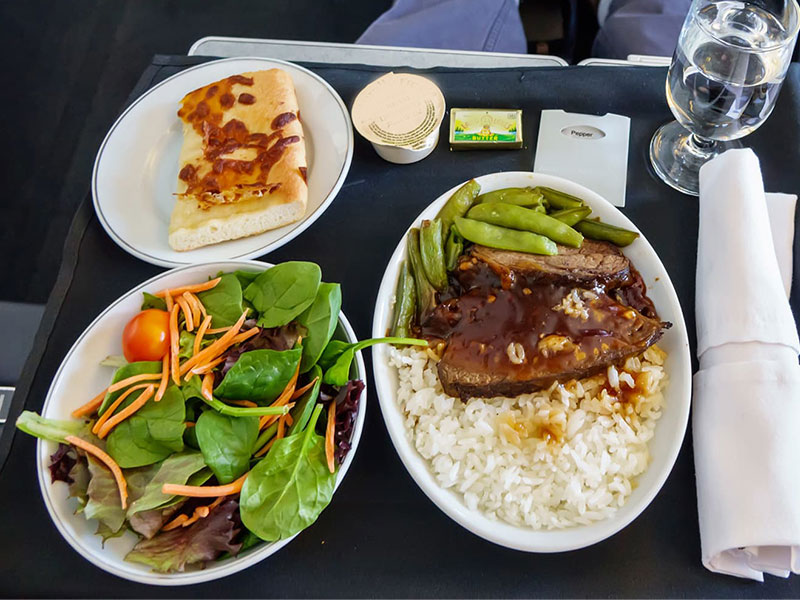
Most airlines offer Meal Selection Service to reserve airplane food in advance of your flight to cater to the needs and tastes of their passengers, as well as to ensure the health and accommodate religious beliefs of travelers. This process, from food reservation to its service during the flight, depends on the flight route, duration, airline facilities, and many other factors, varying from one airline to another.
Meal Selection Service will soon be added to the list of FlySepehran online services, allowing you to reserve your meal before the flight.
You might be surprised to know that all major airlines offering meal selection services have an important statement called the “Peanut Allergy Disclaimer.” The reason behind it is the unavoidable issues that can arise from consuming peanuts. This disclaimer regarding the sensitivity of some passengers to peanuts is one of the things most airlines include on their websites to disclaim responsibility for passenger allergies. A sample of this statement, with a similar structure and minor content variations, can be found on the websites of most airlines.
If you have allergies to nuts, such as peanuts, or any other food substance, please be aware that severe allergic reactions should be taken seriously during your flight. If you have an allergy to a specific food item (like peanuts) and are aware of your allergy, please consult your doctor before flying and take the risks of food allergies seriously before traveling.
So, if you are susceptible to any serious allergic reaction due to the consumption of nuts and other food items, carry your doctor’s report and your allergy medication in your carry-on bag.
Note that having a doctor’s prescription for carrying medication is mandatory for passing through airport security gates.
If you do not have a doctor’s prescription for your self medication, you will be denied entry to the airport. If you have allergies to nuts and peanuts, inform the flight crew in case of an emergency and present your medication and your doctor’s note for necessary actions. While flight attendants are trained in providing first aid, if you have a severe allergy, we recommend traveling with a family member.
It is necessary to know that the snacks served during the flight may include peanuts or various types of nuts. Therefore, if you have allergies to peanuts or nuts, please notify us at least 48 hours before the flight so that a hypoallergenic menu (free of peanuts) can be prepared for you.
Note1: Despite taking precautionary measures, we cannot accept any responsibility for allergic reactions resulting from snacks, nuts, and peanuts, as we cannot ensure that other passengers do not have snacks like peanuts with them.
Passengers who do not disclose their severe allergy during ticket booking or meal selection and notify it upon boarding or inside the flight may be prevented from boarding the plane due to safety considerations. Such passengers travel at their own risk, and the airline is not liable for any allergy-related issues. Passengers with severe food sensitivities are allowed to bring their own meals on board. However, specific restrictions apply to heating, storing meals in the refrigerator, or other matters.
Note2: All major airlines that offer reservation and meal services publish such a statement with variations in its content and based on their facilities and regulations.

If your journey is long and the airline you are traveling with offers meal selection services, we recommend that you choose and reserve your meal before the flight (during ticket purchase or a few days prior to the flight) via the airline’s website. However, before doing so, keep these points in mind:
Take note of how far in advance you can reserve your meal before the flight. For example, some airlines allow meal reservations up to 24 hours before the flight, depending on the available resources in the catering department and other areas involved in meal preparation and service. In some airlines, you may need to select your meal a few days before the flight.
When can passengers cancel their meal request or change it to a different meal? This is another aspect that varies depending on the facilities and regulations of each airline.
How do you go about submitting your meal request? For instance, do you make the request through the airline’s website or contact the customer service department to register your request?
Are you a member of the airline’s frequent flyer club? Special facilities may be provided for you. It’s a good idea to visit the airline’s website or the frequent flyer club platform and take a look at the list of club benefits and services for different membership levels.
Is the selection of airplane meals free, or do you need to pay separately from the airline ticket cost? Note that on some short-haul routes, in-flight catering services may be complimentary but limited, while on some long-haul routes, you may need to pay a separate fee for meal selection.
If you are a Muslim, Hindu, or a follower of any religion with specific rules and regulations regarding slaughter and packaging, search the website of your chosen airline, as they may offer special meals that comply with the dietary laws of various religions. We have provided more details on this matter in the Airplane Meal Menu section.
This pertains to the possibility of bringing food on the airplane, particularly for passengers with food sensitivities or those carrying infant food on the flight. Is it possible to bring solid food items (not liquids or gels) in your carry-on luggage onto the plane? Are there any specific food items that do not violate the airport security regulations of your destination country? These are details you should definitely be aware of before your flight. Also, make sure to check the regulations for bringing baby food (for children under 2 years old) on the plane, whether it’s in the form of milk or other infant-specific foods before your flight.
This concerns the heating of food on the plane or preserving food for passengers with food sensitivities who bring their own meals on the plane. These are essential considerations to be aware of before your flight.
If you have multiple consecutive flights, is it possible to reserve meals for all of them? It’s a good idea to visit the airline’s website and see if you can reserve meals for all your flights.
If your flight schedule changes, do you need to cancel your meal order, or is it automatically canceled with the change in flight schedule? For this, check the airline’s website of the airline you intend to fly with.
If you wish to request a different meal after boarding the plane, can you change your meal order?
Note 1: Before anything else, visit the meal selection section on the website of your chosen airline. If you don’t find the answer to your question, refer to the Frequently Asked Questions (FAQ) section. If you still can’t find an answer to your question, contact the customer service department of that airline and inquire about meal choices and related details.
Note 2: It doesn’t matter whether you purchase your ticket directly from the airline’s website (such as FlySepehran) or through ticket booking websites and airplane ticket booking apps. If the airline you intend to travel with offers such services, the option to utilize those services is only available on the website of that particular airline.
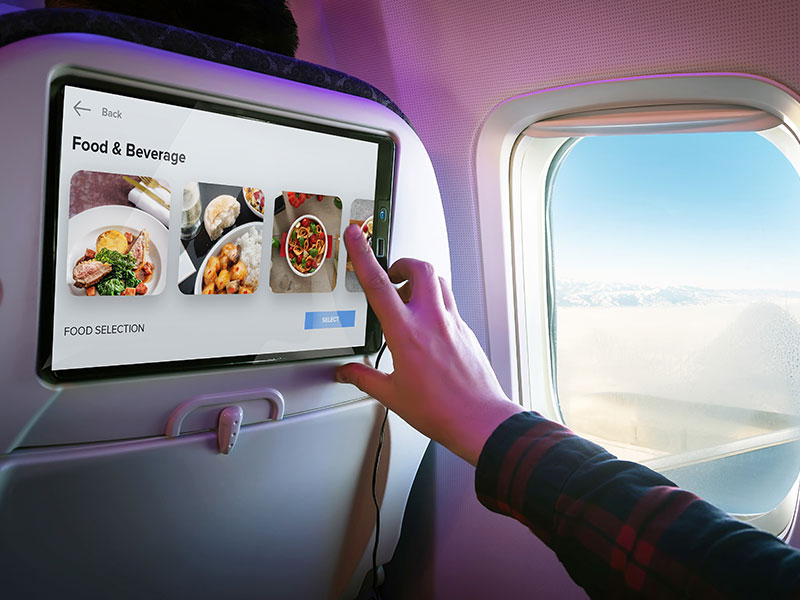
Now, let’s talk about of the airplane menu. It’s important to note that airplane menus vary due to the facilities of different airlines, various flight routes, the drive to create a competitive advantage, the nationalities of passengers traveling with that airline, and many other reasons. However, in general, major world airlines that fly to multiple countries offer a list of different types of meals in their in-flight menus.
Airplane meals encompass various types and have their own subcategories and specialties, which can be intriguing to read about.
Most major airlines offer various dietary meal options such as diabetic meals, low-sodium meals, low-cholesterol meals, and more to meet specific dietary requirements on most of their flights.
Types of Diet Meals |
||
| 1 |
Gluten-Free Meal (GFML) |
This meal is for passengers following a gluten-free diet. It may include fresh fruits and vegetables, rice, gluten-free bread, soy milk, potatoes, soy and rice flour, dairy products, lean meat, and fish.
This meal is free from wheat, wheat flour, caviar, barley, pasta, bread, pastries, meat flavor enhancers, dried fruits and nuts, malt products, and gluten-containing chocolates. It is prepared for passengers with gluten sensitivity or intolerance. |
| 2 |
Bland Meal (BLML) |
This meal is designed for passengers who prefer light and easily digestible foods. It consists of low-fat foods that help prevent stomach discomfort. It may include items such as boiled meat, soft vegetables, mashed potatoes, milk, dairy products, and steamed or boiled ready-made foods, which are considered easy to prepare.
This meal excludes fried or fatty foods, nuts, garlic, onions, spicy seasonings, pickles, and mustard. In general, ingredients that have the potential to irritate the stomach are not used in the preparation of this meal. |
| 3 |
Low-Sodium Meal (LSML) |
This meal is designed for passengers who follow a low-sodium diet, and no salt is added during its preparation. It may contain items such as fresh or frozen foods with minimal salt content. The flavor of the food can be enhanced using herbs and spices.
This meal is free from salt, baking powder, shellfish, salted meats or fish, canned vegetables, pickles, and salted cheese. A low-sodium diet is often recommended for individuals with cardiovascular and kidney issues. It is low in salt and fat and does not cause bloating. |
| 4 | Non-Lactose Meal (NLML) | This meal is designed for passengers who have lactose sensitivity and cannot consume dairy products. It may include items such as meat, fish, pasta, rice, potatoes, vegetables, and fruits. However, it excludes milk, yogurt, cheese, croissants, ice cream, milkshakes, pudding, and other dairy products. |
| 5 | Low-Calorie Meal (LCML) | This meal is designed for passengers who are on a low-calorie diet. It may include items such as lean meats, low-fat dairy products, complex carbohydrates, and steamed or boiled ready-made foods. However, it excludes fried or fatty foods, sugar, full-fat dairy, fatty meats, desserts, and sauces like mayonnaise and salad dressings. |
| 6 | Low-Cholesterol/Low-Fat Meal (LFML) |
This meal is designed for passengers who follow a low-fat diet with limited amounts of saturated fat. It may include items such as lean meats, chicken, fish, low-fat dairy products, egg whites, whole grain bread, fresh fruits, and steamed or boiled ready-made foods. However, it excludes fried or fatty foods, animal fats, egg yolks, dairy products, cream, shellfish, fatty meats, and nuts. A low-cholesterol diet contains less than 100 milligrams of cholesterol and is devoid of animal fats. |
| 7 | Diabetic Meal (DBML) | This meal is prepared for diabetic travelers (with high blood sugar levels). The meals are very low in sugar and contain balanced amounts of protein, fat, fiber, and carbohydrates. This meal excludes fried or fatty foods, sugar, syrups, jams, and desserts. |
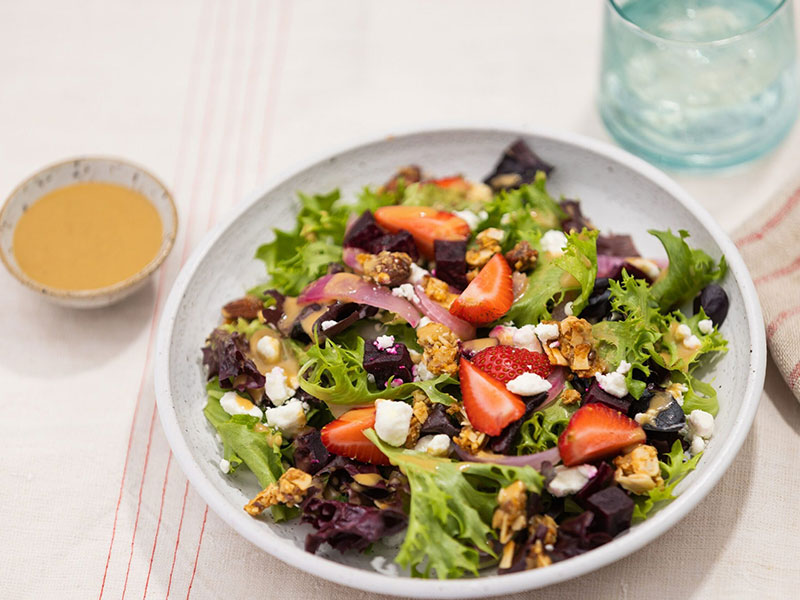
These meals are designed for travelers who, for medical reasons or personal preference, prefer plant-based foods. Plant-based meals can range from various raw plant-based options to strict vegetarian diets, which we will discuss further below.
|
Vegetarian Meals |
||
| 1 | Plant-Based Meal (VGML) | This is a completely plant-based meal, free from any animal products, including honey, eggs, and dairy. It may include vegetables, grains, and fruits, but it excludes all forms of meat, poultry, fish, cheese, honey, eggs, milk, and dairy products. |
| 2 | Fruit Plate (FPML) | This meal consists solely of dried and fresh seasonal fruits. |
| 3 | Raw Vegan Meal (RVML) | This meal is for travelers who prefer only raw vegetables with various fresh fruits. It includes raw vegetables and fresh fruits. This meal excludes meat, poultry, fish, seafood, eggs, caffeinated beverages, highly processed foods, additives, and preservatives. |
| 4 | Lacto-Ovo Vegetarian (VLML) | This is a vegetarian meal that includes eggs and dairy products. It may contain vegetables, fruits, cheese, eggs, dairy products, and soy products. However, it excludes meat, poultry, fish, and seafood. |
| 5 | Eastern Vegetarian Meal (VOML) | This is a plant-based meal Eastern. It may include vegetables, grains, and fruits. However, it excludes meat, poultry, fish, seafood, eggs, milk, and dairy products. |
| 6 | Asian / Indian Vegetarian (AVML) | This is a plant-based meal flavored with spices from the Indian subcontinent. It may include vegetables, fruits, dairy products, spices, and flavors associated with the Indian subcontinent. This meal can be prepared with mild spices. It excludes meat, poultry, fish, seafood, and eggs. |
| 7 | Hindu Non-Vegetarian (HNML) | This meal is prepared in accordance with Hindu dietary requirements. It is non-vegetarian and prepared in a mild Indian style with spices. It may contain lamb, chicken, fish, eggs, milk, and dairy products, but it excludes beef, veal, beef-based sauces, and beef extracts. |
| 8 | Vegetarian Jain Meal (VJML) | This is a vegetarian Indian meal prepared in accordance with the Jain religious rules. It may include leafy vegetables and fruits grown above the ground. However, it excludes meat, poultry, fish, seafood, eggs, dairy products, and root vegetables, as well as onion, garlic, potatoes, ginger, and the like. |
| 9 | Asian Vegetarian Meal (AVML) | This meal is prepared for vegetarian travelers who prefer Indian-style vegetarian dishes, complete with various Indian sauces and spices. It may contain some or all of the following: vegetables, fresh fruits, dried fruits, legumes, dairy products, tofu, and grains. It does not include any kind of meat, meat products, fish, seafood, eggs, or animal-based gelatin. |
| 10 | Full Vegetarian Meal (VGML) | This meal is designed for travelers who do not consume dishes containing animal products. It includes some or all of the following: high-protein foods such as lentils, tofu, beans, vegetables, fresh fruits, dried fruits, and nuts rich in iron and calcium. However, it excludes animal products such as meat and meat derivatives, honey, eggs, dairy products, fish, and poultry. |
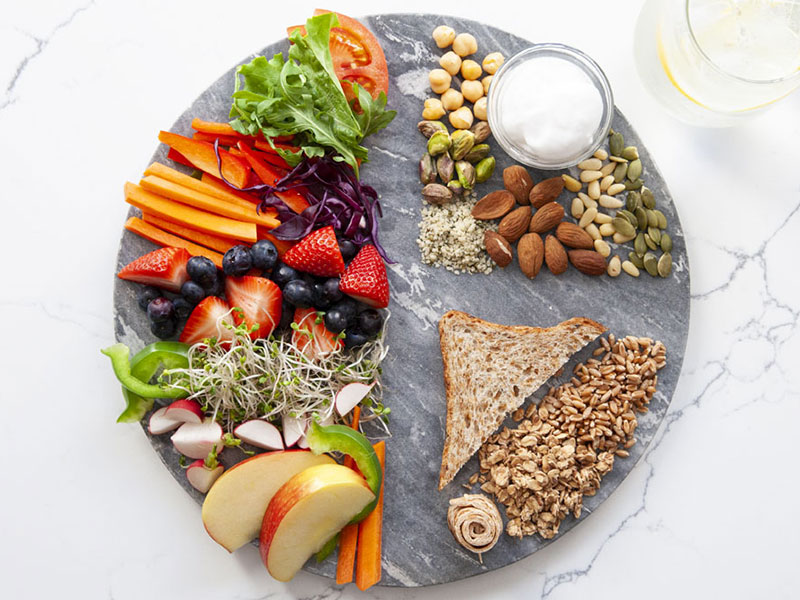
Followers of different religions can choose their preferred meals before their flight. Special dietary options for followers of various religions include Islamic, Kosher, and Jain meals. Below, we introduce the different types of dietary options for various religions.
Dietary Options for Religious Followers |
||
|
1 |
Islamic Meal (Halal) | The Islamic meal is prepared for Muslims and does not contain pork, any form of game, or alcohol. All meat and poultry products used are certified as Halal according to the Halal guidelines. |
|
2 |
Kosher Meal (KSML) | This meal is prepared in accordance with Kosher standards and follows Jewish dietary laws. It is purchased as pre-packaged meals from reputable producers or prepared and packaged under the supervision of a Rabbi. |
|
3 |
Jain Meal (VJML) | This meal is prepared for vegetarian travelers who strictly adhere to Jain principles. It does not include chicken, meat, fish, seafood, eggs, dairy products, root vegetables, onions, or various types of roots. It may contain some or all of the following: fruits, vegetables, pickles, tofu, legumes, rice, and grains. |
In Islamic countries such as Iran, Turkey, and countries in the Persian Gulf region, you won’t need to reserve Islamic meals because in Muslim countries, food is prepared and cooked according to Islamic laws, and airlines also follow the regulations and rules for slaughtering and preparing Islamic food.
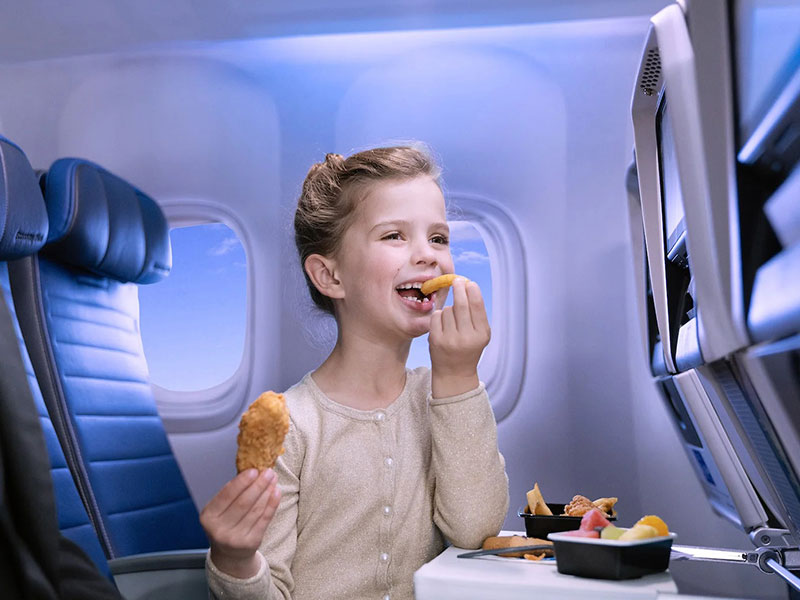
Most major airlines worldwide offer meals for infants (under 2 years) and children aged 2 to 12, known as “Children’s Menus.”
Children’s Menus |
||
|
1 |
Infant Meal (BBML) | This is a standard meal for infants that usually does not require advance reservation. Infant meals are served in glass containers for travelers under 2 years old. |
| 2 | Children’s Meal (CHML) | This meal is prepared and served according to the nutritional needs of children aged 2 to 12. It may include some or all of the following: grated carrots, cheese, crackers, finger foods, fresh fruit, fruit juice, meat puree, pancakes, pasta, and fried chicken. It does not contain fish or bone-in meat, dried fruits, nuts, grains, spicy foods, sauces, dry and hard sweets, wheat, gluten, fish, eggs, acidic fruits, or beef. |
Beverage service on an aircraft can include two types:
These beverages can be served alongside meals or afterward. Cold beverages include various fruit juices and carbonated drinks, while hot beverages consist of tea, coffee, and herbal tea.
Large world airlines, especially on long-haul flights, serve main meals along with desserts. The website https://www.flightcentre.co.uk introduces the best desserts on flights from airlines such as Virgin Atlantic, Delta, Qantas, Hawaiian Airlines, JetBlue, Emirates, and British Airways. These desserts include Gü Puds, various mini cheesecakes, chocolate mousses, cookies, Greek yogurts, chocolate gateau, baklava, mango tart, and Turkish delight.
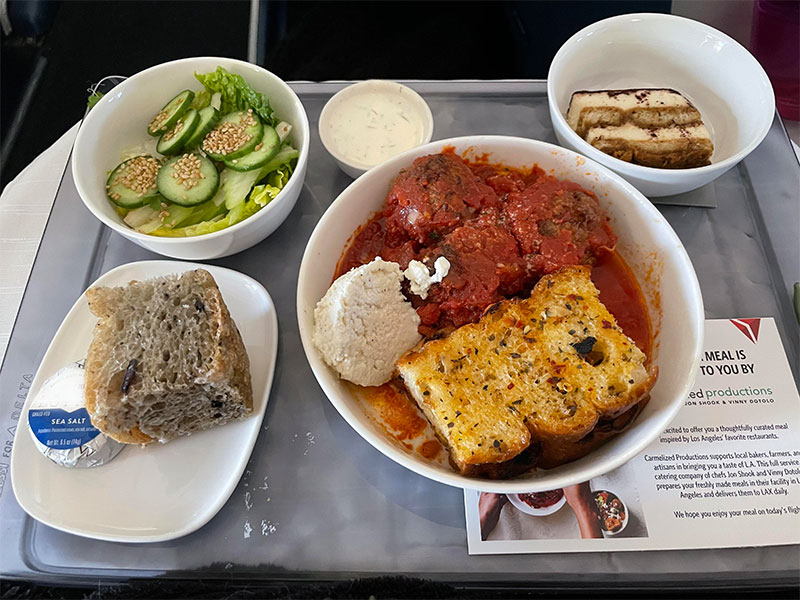
The timing of meal service on an airplane and whether it’s breakfast, the main meal, or a snack depends on the time zone and the duration of your flight. On long-haul flights, the service may include multiple courses, snacks, the main meal, and hot beverages. Generally, meal service times on flights are as follows:
*Note: On some airlines, meals are available for purchase during the flight.
The first airplane meal was a very simple sandwich served on a KLM flight from London to Paris. Following that, American airlines started offering passengers hamburgers and water during their flights. Now, over 100 years have passed since the first airplane meal in 1919, and in-flight catering has evolved to the point where you can choose your meal based on your dietary preferences or religious beliefs.
Airplane food is prepared in large industrial kitchens. After cooking, the meals are quickly chilled and packaged to stay fresh during transportation and throughout the flight. Before serving in-flight, they are reheated.
If airplane food doesn’t appeal to your taste and seems somewhat bland, the reason might be the high altitude, dry cabin air, and reduced humidity, which affect your sense of smell and make it challenging to perceive the taste of food correctly. Additionally, the reduced air pressure at that altitude involuntarily affects your taste buds, making airplane food less flavorful.